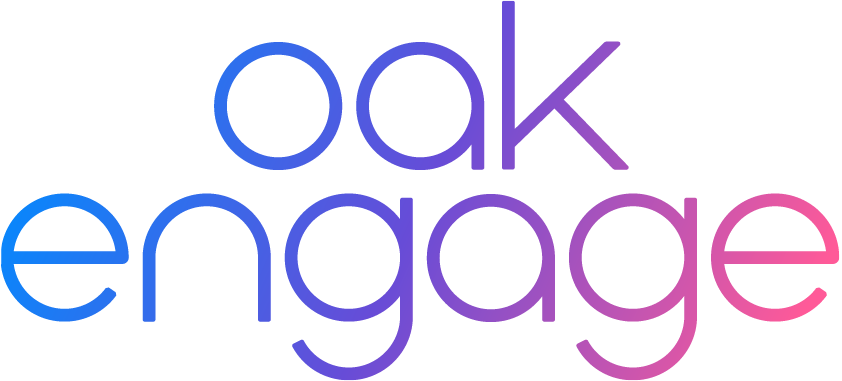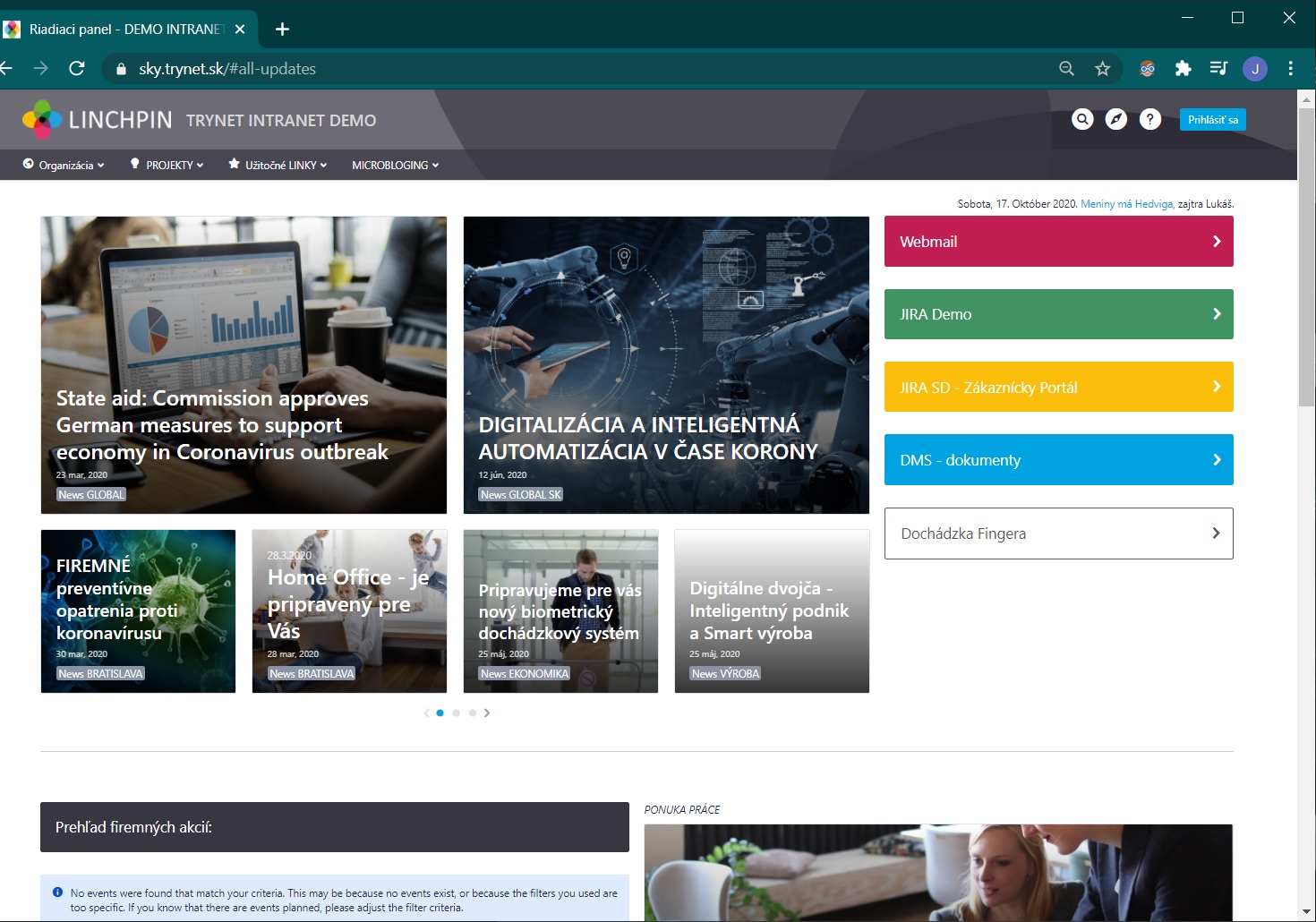Choosing the best intranet software platform can feel overwhelming. Thankfully, once you know what you're looking for and why you're looking for it, your decision becomes that little bit easier. It's all about understanding your needs and how an intranet can help you achieve your goals. Every intranet vendor brings different strengths and limitations, so clarity on your goals is essential. And today, those goals have never been more important. Employee communication has evolved rapidly, workforces are more distributed than ever and digital noise is at an all-time high. In fact 74% of employees in organisations feel they’re missing out on company news because internal communication is either non-existent or executed poorly. When communication breaks down, so does the effectiveness of day to day operations. This in turn, then affects the bottom line. Disengagement is costly, reduced productivity costs UK workforces £50-70 billion a year.
Eventually, most organisations reach a point where information becomes scattered, culture starts to fragment, and employees waste valuable time searching for what they need. For many businesses, that tipping point appears at around 200 employees, when complexity scales faster than communication. This is the moment an intranet stops being a nice-to-have and becomes essential, or as some teams describe it, “the moment chaos becomes a project.”
This guide is designed to bring clarity to that moment. It provides a clear, structured, and honest comparison of the top 16 intranet software platforms, helping you identify the solution that best fits your needs and giving you the insight to tackle your internal comms chaos with confidence.
Let’s start with the basics and then we'll jump into the most practical intranet buying guide you’ll read this year.
What does the best intranet software platform offer?
The best intranet software acts as a central digital workplace where employees access communication, knowledge, updates, and essential tools. It provides one connected space that keeps people informed, aligned, and engaged with their organisation.
Most top tier intranets typically include:
-
Employee news and announcements
-
Document storage, policy hubs and knowledge libraries
-
Personalised content based on role or location
-
Mobile access for frontline and remote workers
-
Social features such as comments and recognition
-
Integrations with Microsoft 365, Google Workspace and HR systems
-
Analytics to understand and improve communication
A strong intranet makes the employee experience easier, clearer and more connected.
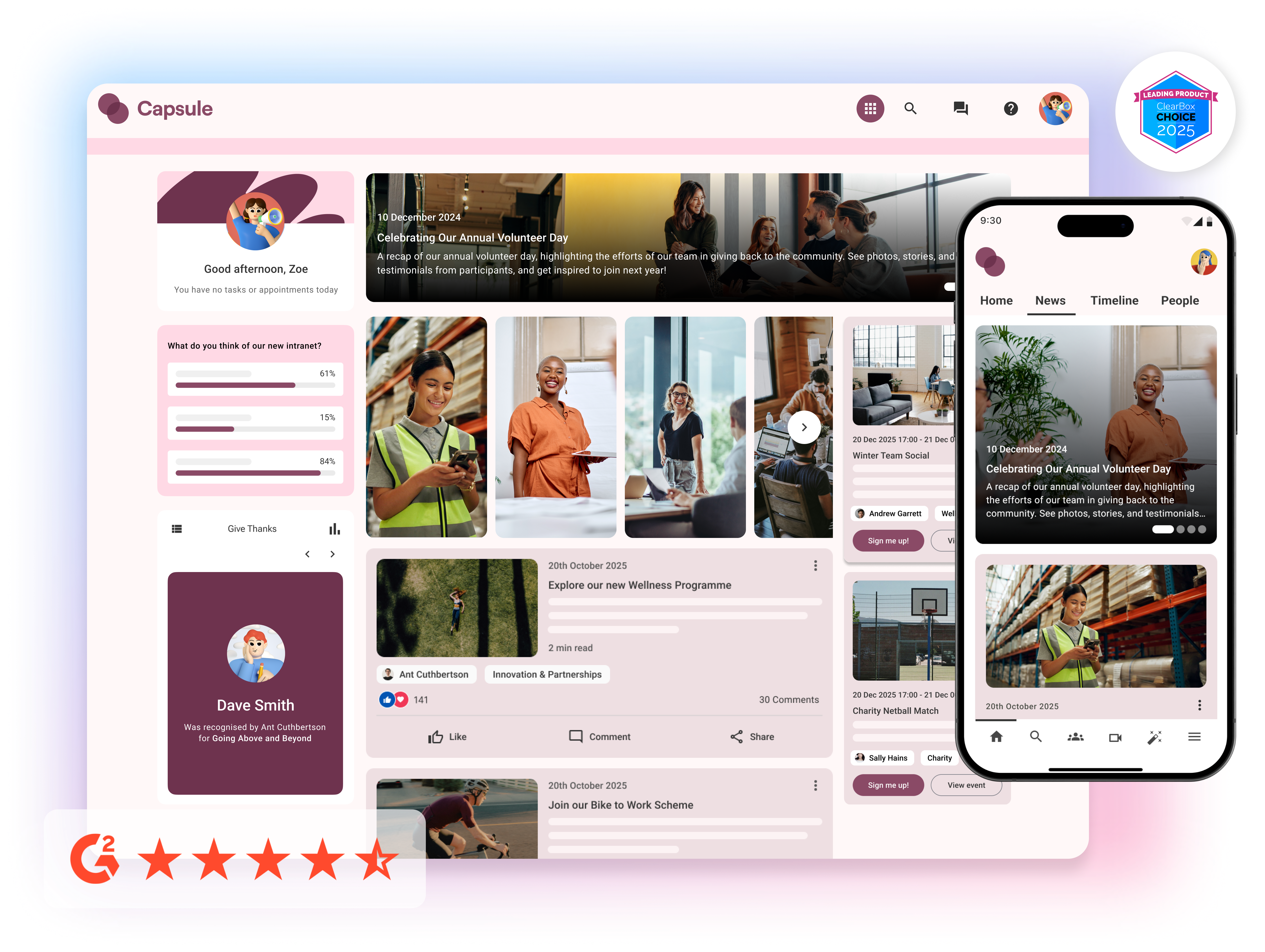
How do you know you need an intranet?
Most organisations outgrow a mixture of email, Teams, Slack, WhatsApp, noticeboards and file shares long before they realise it. Common signs include:
1. Communication is scattered across too many channels
Important information gets buried or ignored.
2. Frontline or remote workers feel disconnected
Different groups get different messages, creating inconsistency.
3. People ask for documents and policies constantly
Information isn’t centralised or easy to find.
4. Culture feels fragmented
Teams operate in silos and connection suffers.
5. You can’t measure communication effectiveness
Without analytics, you’re guessing what’s working.
6. You have more than 200 employees
If more than one of these resonates, you're ready for an intranet and the ranking below will help you choose the right one.
Best intranet software platform: quick overview
This ranking reflects a synthesis of publicly available vendor data, common market positioning, and broadly accepted industry observations.
| Rank | Platform | Best For | Org Size Fit | Price Level | Key Strength | Key Limitation |
|---|---|---|---|---|---|---|
| 16 | Zendesk Guide | Knowledge-heavy, support-driven teams | 50–5,000 | $ | Powerful knowledge base & search | Not suitable as a full intranet |
| 15 | Confluence (Atlassian) | Engineering & technical documentation | 50–10,000 | $–$$ | Excellent documentation & collaboration | Not a communications intranet |
| 14 | Firstup | Global multi-channel communications | 5,000–200,000 | $$$$ | Industry-leading targeting & analytics | Not a full intranet (comms engine only) |
| 13 | SharePoint (OOTB) | Microsoft 365-centric organisations | 100–100,000 | $–$$ | World-class document management | Requires heavy config to be a polished intranet |
| 12 | Jostle | Simple, culture-driven organisations | 50–5,000 | $$ | Very easy adoption & user-friendly UI | Limited depth for enterprise structure |
| 11 | Simpplr | Modern, communications-led intranets | 500–50,000 | $$$ | Polished UX + strong governance | Less flexible for complex intranet structures |
| 10 | Happeo | Google Workspace-focused companies | 100–5,000 | $$ | Quick deployment + strong Google integrations | Limited governance & deep enterprise features |
| 9 | Haiilo | Advocacy + internal comms | 200–10,000 | $$ | Strong mobile experience & advocacy tools | Limited deep knowledge management |
| 8 | MangoApps | All-in-one platform seekers | 50–5,000 | $ | Broad toolkit: intranet + chat + tasks | Feature depth inconsistent |
| 7 | Igloo | Structured, process-heavy teams | 200–5,000 | $$ | Strong modular architecture | Older UX vs modern competitors |
| 6 | Interact | Compliance & policy-heavy industries | 500–20,000 | $$$ | Excellent search + governance | Less engagement-focused |
| 5 | Workvivo (Zoom) | Culture-first organisations | 200–20,000 | $$–$$$ | Outstanding engagement & mobile UX | Limited complex intranet structures |
| 4 | Staffbase | Frontline communication | 500–50,000 | $$$ | Best-in-class branded mobile app | Thin knowledge management |
| 3 | LumApps | Global multilingual enterprises | 1,000–100,000 | $$$$ | Personalisation + multilingual depth | Less aligned to Microsoft-heavy stacks |
| 2 | Unily | Large global enterprises | 1,000–200,000 | $$$$ | Deep governance & enterprise scalability | Long deployments; heavier complexity |
| 1 | Oak Engage | Mid-large enterprise organisations | 500–20,000 | $$ | Balanced intranet communications and engagement; enterprise-grade value | Slightly fewer reviews than giants |
What Should You Look for in Intranet Software?
Choosing intranet software is about finding a platform that makes communication clearer, access to information easier and the employee experience more connected. The strongest intranets are intuitive, mobile-friendly and designed to support every type of worker, from office-based to fully frontline.
When evaluating options, organisations typically focus on usability, mobile access, integrations, governance, personalisation and analytics. A modern intranet should reduce noise, surface relevant content to the right people and integrate seamlessly with your existing digital ecosystem. For enterprise organisations, scalability and robust governance are critical to maintaining consistency as teams, locations and content grow.
Intranet software pricing: what to expect
Most intranet platforms use a subscription-based model priced per employee per month. Costs vary depending on required features, support, integration needs and organisational size. Enterprises often invest more due to complex structures, governance requirements and larger user numbers.
Mid-sized organisations may look for more straightforward pricing with rapid implementation. Being clear about your needs and scaling expectations will help you choose the right package and avoid hidden costs later.
Why this countdown exists
Once you realise you need an intranet, the next question becomes:
“Which intranet is actually right for us?”
This is where most organisations get stuck.
Different intranets serve different needs:
-
Some excel with frontline workers
-
Some specialise in knowledge management
-
Some prioritise culture and engagement
-
Some are built for global enterprise complexity
-
Some are perfect for mid-sized organisations
This countdown was created to help you match your challenges with the platform designed to solve them.
The top 16 intranet software platforms on the market right now
16. Zendesk Guide (as an Internal Knowledge Hub)

Overview
Zendesk Guide is a powerful knowledge base solution often used as a lightweight intranet alternative in support-heavy or documentation-driven organisations. It excels at centralising structured knowledge, FAQs, help content and self-service resources. While not a full intranet, it provides a clear, searchable hub that improves information access and reduces support burden.
G2 / review scores
-
Rated 4.3 out of 5 stars on G2 (600+ reviews).
-
Highly rated for search capabilities, content organisation and ease of authoring.
-
Review sentiment includes: “Guide makes it incredibly easy to build and maintain help content.”
-
Another user notes: “Search actually works — our teams find documents instantly.”
Pros
-
Excellent structured knowledge management: Ideal for documentation, FAQs and help articles.
-
Simple, intuitive authoring tools: Non-technical users can easily create and update content.
-
Powerful search functionality: Employees can quickly find what they need.
-
Affordable option: Significantly cheaper than full intranet solutions.
Cons
-
Not a full intranet: Missing social feeds, news, engagement features and broad comms tools.
-
Limited design flexibility: Branding, layout and theming options are basic.
-
Not designed for organisation-wide communication: Works best as a knowledge hub.
-
May require pairing with other tools: Often complemented with a comms or intranet platform.
Best fit
Support, operations and documentation-heavy teams that need a low-cost, easy-to-manage knowledge base rather than a full intranet. Excellent for organisations focused on help content and self-service.
15. Confluence (Atlassian)
Overview
Confluence is a collaborative workspace and knowledge platform widely adopted by engineering, product and technical teams. Although not designed as a formal intranet, it excels at documentation, project collaboration, team spaces and structured knowledge sharing. Many organisations use Confluence as a knowledge layer or internal wiki alongside an existing intranet.
G2 / review scores
-
Rated 4.1 out of 5 stars on G2 (3,000+ reviews).
-
Praised for documentation depth, collaboration and flexibility.
-
Typical review sentiment: “Confluence is the single source of truth for our engineering team.”
-
Another user states: “Easy to organise, easy to edit, easy to scale.”
Pros
-
Excellent documentation and knowledge organisation: Ideal for technical content, wikis, specs and project pages.
-
Deep Atlassian integration: Works seamlessly with Jira, Trello and other Atlassian tools.
-
Flexible content structure: Supports nested pages, templates and collaborative editing.
-
Affordable and scalable: Works for small teams through to large enterprises.
Cons
-
Not a communications intranet: Missing news, social feeds and broad comms tools.
-
Limited branding and UX customisation: Practical but not visually polished.
-
Weak governance: Not suitable for organisations needing strict content control.
-
Requires another platform for engagement: Not designed to drive organisation-wide culture.
Best fit
Engineering, product and technical organisations needing a robust documentation and collaboration hub. Best used as a complement to — not a replacement for — a full intranet or communications platform.
14. Firstup

Overview
Firstup (formerly SocialChorus) is a large-scale employee communication and workforce orchestration platform designed for enterprises with complex, multi-channel communication needs. Rather than functioning as a full intranet, Firstup acts as a central communications engine that distributes targeted messaging across email, mobile, digital signage, SMS, and other channels. It is built for organisations that need precision targeting, automation, segmentation and analytics at global scale, especially for dispersed, frontline or hard-to-reach workers.
G2 / review scores
-
Rated 4.4 out of 5 stars on G2 (150+ reviews).
-
Highly rated for analytics, audience segmentation and multi-channel delivery.
-
A typical review highlights: “Firstup makes it easy to reach every employee regardless of location or device.”
-
Another user notes: “The targeting capabilities are unmatched and let us personalise communication at scale.”
Pros
-
Industry-leading automation and targeting: Highly granular audience segmentation and message scheduling across multiple channels.
-
Deep analytics: Strong insight into message reach, engagement, and behavioural patterns across global teams.
-
Excellent for frontline activation: Built specifically to reach non-desk workers who often miss intranet-based communication.
-
Ideal for global campaigns: Supports high-volume, multi-channel communication across regions, languages and time zones.
Cons
-
Not a full intranet: Lacks deep content structure, document management and rich intranet features.
-
Higher cost tier: Premium pricing makes it more suitable for enterprise-budget organisations.
-
Requires comms maturity: To maximise value, teams need clear communication strategy and strong change management.
-
May duplicate tools: Often deployed alongside an intranet, not instead of one, increasing ecosystem complexity.
Best fit
Large, global enterprises with complex communication needs, multi-channel audiences and significant frontline workforces. Best used as a communication engine paired with an existing intranet rather than as a standalone solution.
13. SharePoint

Overview
Microsoft SharePoint is a content- and document-centric platform integrated deeply into Microsoft 365. While not built originally as a dedicated “intranet” solution, many organisations adopt it as the backbone for internal communication, collaboration, knowledge management and file storage. Its strength lies in providing a structured, secure document environment that many businesses already pay for through their Office licensing. However, using it as a full intranet experience typically requires additional configuration, customisation or user-experience layering.
G2 / review scores
-
Rated 4.0 out of 5 stars on G2 (2,000+ reviews) — strong for content/document management but lower on out-of-the-box social/engagement features.
-
Real-world feedback shows that many SharePoint intranets stall at low adoption levels unless properly customised.
-
Usage analytics show that, in some organisations, only about one-third of employees engage regularly with a “plain” SharePoint intranet.
-
Example: “We have a modern, effective … single ‘front door’ to our digital campus” – Ross Tarbard, University of Leicester.
Pros
-
Deep Microsoft 365 ecosystem integration (Teams, OneDrive, Outlook, Office apps) gives seamless access across core productivity tools.
-
Very strong foundation for document and knowledge management: version control, structured libraries, metadata, permissions.
-
Flexible architecture: with skilled internal teams or partners, organisations can build custom workflows, sites, and intranet-like structures.
-
Familiar licensing for many organisations already using Microsoft 365, which can make SharePoint a cost-effective intranet foundation.
Cons
-
Out-of-the‐box experience lacks the intuitive UX, mobile engagement, social features and branding polish of dedicated intranet platforms.
-
Organisations frequently report low adoption unless significant change-management, UX redesign and customisation is applied.
-
Without custom work, the experience can feel fragmented—multiple site templates, inconsistent navigation and varying user experiences.
-
Managing the environment (governance, permissions, taxonomy, content cleanup) often requires ongoing resource and maintenance investment.
Best fit
SharePoint suits organisations already heavily invested in Microsoft 365 who prioritise documentation-first intranet foundations and have the internal capability or partner support to customise and maintain the environment. It’s ideal when the primary goal is structured content, compliance, secure document access and integration, less optimal when the priority is rapid deployment, high engagement or frontline/distributed worker access.
12. Jostle

Overview
Jostle is an employee engagement–focused intranet designed to make internal communication simple, social and accessible. Unlike platforms that prioritise complex content structures or deep governance, Jostle centres on connection, culture and clarity, helping organisations create a positive, engaged digital workplace without technical overhead.
Its interface is intentionally lightweight and straightforward, making it easy for employees to find news, updates and people without feeling overwhelmed. Jostle’s philosophy is to reduce clutter, minimise administrative complexity and maximise participation across all levels of the organisation.
G2 / review scores
-
Rated 4.4 out of 5 stars on G2 (250+ verified reviews).
-
Frequently praised for ease of adoption and intuitive design.
-
A G2 reviewer notes: “Jostle is extremely easy for the whole company to use — no training sessions needed.”
-
Another user writes: “It’s clean, it’s simple, and people actually WANT to use it.”
Pros
-
Exceptionally easy adoption: Users consistently highlight that Jostle requires almost no training, making rollouts fast and low-effort.
-
Strong for connection and culture: Social features, people directories and community tools help teams feel more aligned and engaged.
-
Clean, uncluttered interface: Designed for non-technical users, ensuring information is easy to find and navigate.
-
Low administrative overhead: Simple management tools and a lightweight structure make upkeep far less resource-intensive than traditional intranets.
Cons
-
Limited enterprise-level structure: Not built for organisations needing advanced governance, complex permissions or deep content hierarchies.
-
Lacks sophistication for large, complex intranet architectures: Better suited to straightforward communication rather than heavy documentation or workflows.
-
Modest branding and design flexibility: Focus on simplicity means fewer options for heavy customisation or redesign.
-
Not ideal for regulated or compliance-heavy industries: Missing some of the governance and workflow depth required at scale.
Best fit
Jostle is an excellent fit for small to mid-sized organisations that value connection, culture and simplicity above deep intranet structure. It is ideal for teams who want an easy-to-use, engagement-first intranet that launches quickly, encourages participation and keeps admin workload minimal. Perfect for organisations where the top priorities are communication clarity and a strong sense of community.
11. Simpplr

Overview
Simpplr is a modern, communications-focused intranet platform designed to provide a clean, intuitive and highly polished employee experience. Positioned as a next-generation intranet, it emphasises simplicity, governance and a consistent, branded UX that helps organisations deliver clear, effective internal communication.
Simpplr incorporates AI-driven personalisation, automated content governance, smart recommendations and structured publishing workflows, making it particularly appealing to organisations that want a high-impact intranet with minimal complexity. Its philosophy centres on delivering a “no-coding, no-chaos” experience where employees can effortlessly find news, resources and tools.
G2 / review scores
-
Rated 4.7 out of 5 stars on G2 with 300+ verified reviews — among the highest in its category.
-
Ranked highly for ease: Ease of Use ~9.4, Quality of Support ~9.3, Ease of Setup ~9.1.
-
Real-world reviewer feedback often praises its simplicity: “Simpplr makes it so easy for users to find what they need without getting lost.”
-
Another G2 review highlights reliability: “The platform is always up, consistent and requires minimal admin overhead.”
Pros
-
Exceptionally polished and consistent UX: Users repeatedly comment on how simple and intuitive Simpplr is, with a clean design that feels modern and easy to navigate.
-
Strong governance and content automation: Built-in workflows, expiry automation, and quality controls help organisations keep content fresh and compliant without manual effort.
-
AI-driven personalisation: Smart recommendations surface relevant content to each employee, improving relevance and reducing noise.
-
High support satisfaction: Customers frequently praise Simpplr’s responsive customer success team for being proactive and easy to work with.
Cons
-
Less flexible for deep or complex intranet structures: Simpplr prioritises simplicity, so organisations needing intricate site architectures or highly customised knowledge frameworks may find it limiting.
-
Higher pricing tier: Positioned as a premium solution, making it less accessible for budget-constrained organisations.
-
Customisation trade-offs: To preserve UX consistency, design flexibility is intentionally constrained fewer options for bespoke layouts or advanced theming.
-
May feel light for documentation-heavy teams: Companies needing extensive structured content may prefer a more documentation-centric platform.
Best fit
Simpplr is best suited for mid-sized to large organisations seeking an elegant, modern, communications-first intranet with minimal complexity. It works particularly well for organisations focused on employee experience, brand consistency, governance and reliable, high-quality internal communication. Ideal for companies that want a polished, engagement-driven intranet rather than a deeply structured or engineering-heavy content platform.
10. Happeo

Overview
Happeo is a social-style intranet built especially for Google Workspace users, it integrates with Google Drive, Gmail, etc. It’s marketed as a “digital home” for teams, emphasising speed, simplicity and social interactions.
G2 / review scores
-
In Happeo’s own blog they cite a G2 rating of 4.5 / 5 stars.
-
A G2 compare page lists some category scores: Ease of Use ~9.1, Quality of Support ~9.3 for Happeo in comparison with a competitor.
-
They say, for example: “Happeo’s score of 8.5 for search functionality” in one comparison.
Pros
-
Tight integration with Google Workspace, which makes it especially appealing to organisations already invested in that ecosystem.
-
The social/home-style intranet experience appeals to teams looking for engagement and connection, rather than heavy enterprise structure.
-
Relatively quick to adopt because the UI and social feed type experience are familiar to users.
-
Strong support score (9.3 in one comparator) suggests good post-deployment service.
-
They highlight case studies: e.g., in their blog they list customers like Doctolib, Decathlon, Randstad Sourceright.
Cons
-
Less strong on advanced personalisation, governance, and structure. In the comparison they were rated lower (8.5) for search compared with some enterprise-grade vendors
-
Integration beyond Google Workspace may not be as deep (they themselves state their strongest advantages are “within the Google ecosystem”).
-
If you have very complex communication structures, multi-language, heavy workflows or governance, Happeo may feel less suited than some of the heavier enterprise intranets.
-
The published scores show that while the product direction (~8.9) is good, it might lag the most advanced platforms in roadmap ambition.
Real-world case study
In one of their case stories on their site (for example user ‘OneGoal & Happeo’ mentioned in their product page) they highlight how users were able to reduce time searching for documents via unified search, and increase adoption across the company.
Best fit
Scale-ups or mid-sized organisations that are Google Workspace-centric, looking for a clean, fast, socially-centred intranet. Not ideal if you’re an enterprise with heavy governance, heavy structure, or multi-ecosystem (e.g., heavy Microsoft + non-Google) needs.
9. Haiilo
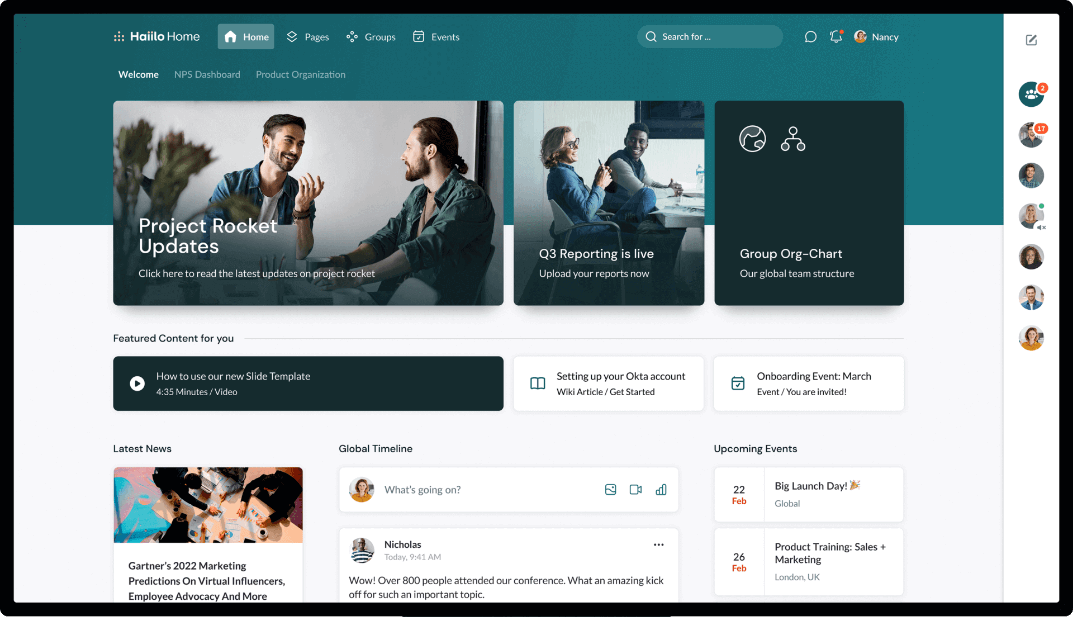
Overview
Haiilo combines internal communication with external advocacy: employees can share company-approved content on social platforms, servant to enhancing employer-brand, while also having intranet-style communications.
G2 / review scores
-
Rated 4.6 / 5 stars based on verified reviews on G2.
-
From user reviews: many strong comments on ease of use, mobile first design, internal communication improvements.
-
In some comparison metrics: unanimous high scores e.g., Content Scheduling ~9.8, Mobile Optimisation ~9.1.
Pros
-
Very strong on advocacy, social intranet, mobile-first experience: users consistently say it’s easy to share content, good for distributed / frontline workers.
-
Good for employer brand amplification: the ability for employees to push content externally adds value beyond just internal comms.
-
Strong mobile experience and good for global / distributed workforces (mobile-first, intuitive UI).
-
Simplified setup and ease of use emphasised by many reviewers.
Cons
-
The intranet/deep structured content/knowledge-management side is less strong than platforms built purely for intranet/knowledge use-cases.
-
If heavy structured workflow, governance, complex taxonomy or global multilingual with deep customization is required, you may find limits.
-
Some feedback indicates limited depth in search, complex process-driven workflows.
-
Also the advocacy focus means tradeoffs: you might not get as robust an intranet backbone as a specialist would provide.
Real-world case study
On the Haiilo website they list brands such as DHL, L’Oréal, Google, KPMG as customers. They also emphasise reaching blue-collar or frontline workers via mobile. For example:
“It’s very easy to share content … the ‘Mobile First’ design … makes it very easy even to reach the blue collar worker of your company.”
Best fit
Organisations where internal comms + employee advocacy + mobile reach (especially frontline) matter more than heavy intranet governance. For example marketing-driven companies, manufacturing/retail chains where brand and employee voices matter. Less ideal if you need heavy knowledge-management or very structured intranet workflows.
8. MangoApps
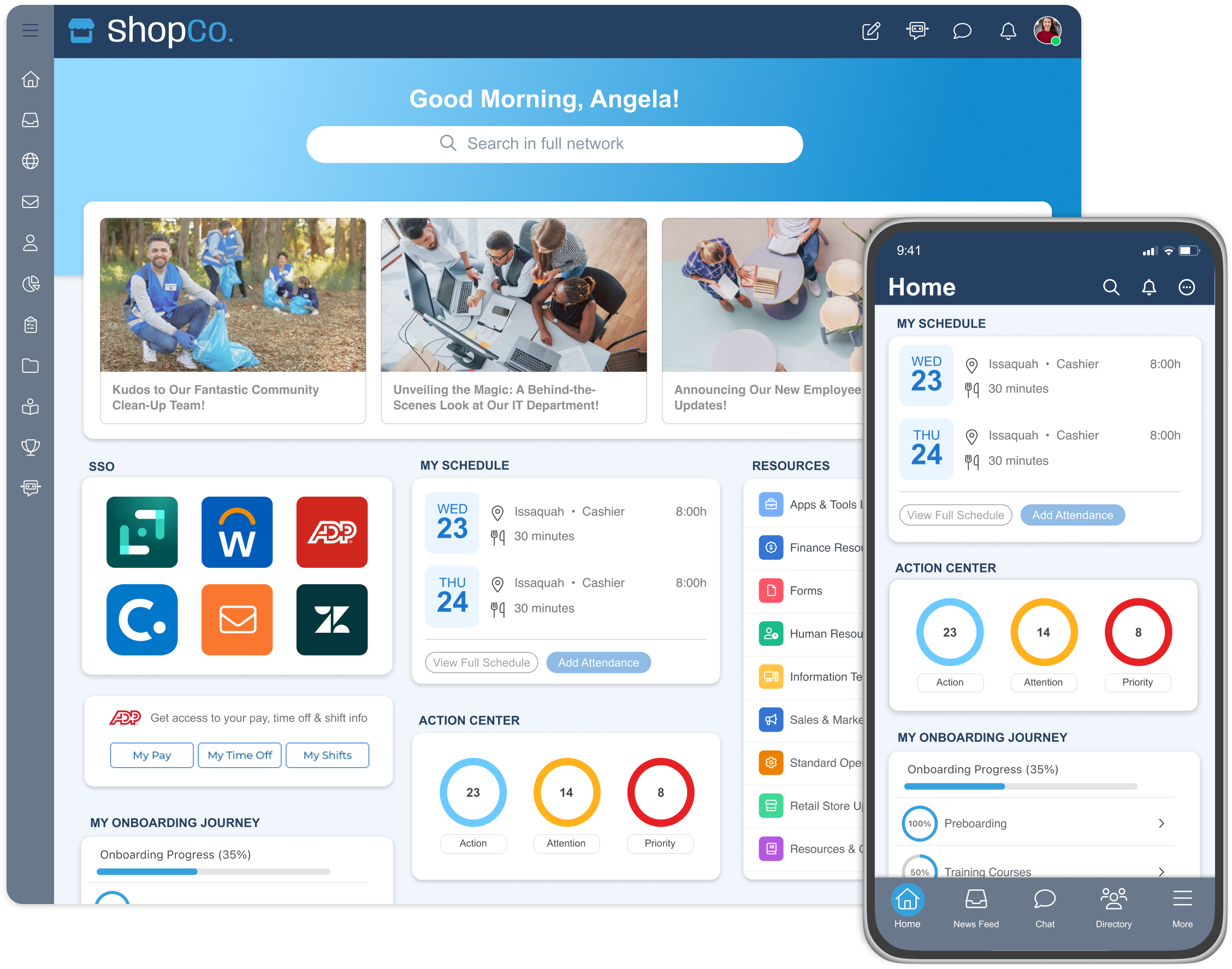
Overview
MangoApps is a broad all-in-one platform that includes intranet, collaboration tools, chat, tasks, training, a “suite” rather than a specialist single intranet component.
G2 / review scores
-
On SoftwareAdvice: users say “This platform is really easy to use … works well with other tools”.
-
Blog article cites a G2 score of 4.2 / 5 for MangoApps (for intranet portals) in a comparison list.
Pros
-
Because it covers many functionalities (intranet + chat + tasks + training) it offers a “one stop shop” which can simplify tool-sprawl.
-
Strong support/implementation feedback: e.g., one reviewer says: “The MangoApps team is one of the best support teams I have ever worked with.”
-
Good for organisations seeking cost-effective, versatile solutions rather than picking many separate tools.
-
Good flexibility and customisation of widgets/pages etc.
Cons
-
Because it tries to cover many areas, the depth in any one area (especially specialist intranet functionality) may be shallower than a dedicated strong intranet platform. One review:
“The downside to having so many features is there are also so many things to learn and it can be overwhelming.” G2
-
Some users report login issues, search limitations, video calls lacking or integration limits. softwareadvice.com
-
If you are a large enterprise with very heavy intranet/governance/personalisations then you may find MangoApps lacks the refinement or scalability compared to specialist enterprise platforms.
Real-world case study
"There’s an absolute return on investment with MangoApps as our partner. We’ve been able to actualize our vision to make community participation and employee engagement happen."
Team Health
Best fit
Organisations wanting a broad employee experience platform inclusive of intranet, chat, tasks, training, especially mid-sized firms or companies with frontline/distributed workforce where having one platform is advantageous. Less ideal if you need a highly tailored, enterprise-grade intranet with deep governance, taxonomy, personalisation and extremely large scale.
7. Igloo Software
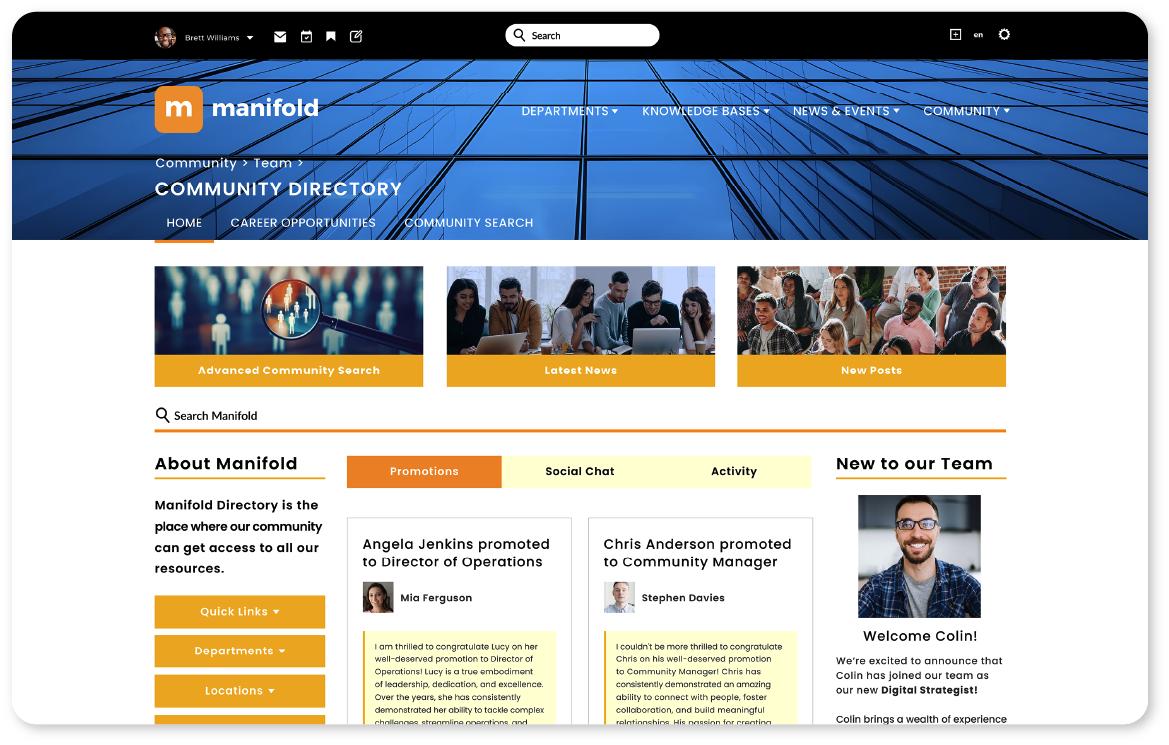
Overview
Igloo is positioned as a modular intranet/knowledge-management platform that allows distributed ownership of spaces, workflows and structured content. It tends to appeal to organisations with departmental or distributed intranet ownership.
G2 / review scores
-
Review snapshot: Ease of Use ~8.4 (vs SharePoint ~7.7) in one comparison.
-
From the “Pros and Cons” summary: users appreciate ease of setup, collaborative workspace, but criticise limited features, customisation complexity, higher cost.
Pros
-
Strong centralised-management + distributed spaces model: departments can have their own portals/spaces, giving flexibility for disparate teams.
-
Good for knowledge management, structured content; one review says:
-
Strong search/file-management is noted in some comparisons: e.g., score 9.4 for search vs competitor.
Cons
-
Some reviews say the page layouts/customisation are limited; the search index needs improvement in their view.
-
Setup ease and admin experience may lag newer platforms; for example the ease of setup score in one comparison was 7.5 for Igloo vs 8.6 for competitor.
-
Price: some reviewers feel the cost is high relative to perceived feature set.
-
The user interface/mobile experience may feel less modern compared with newer intranet platforms.
Best fit
Organisations where structured content, departmental ownership, knowledge management are important; distributed ownership is needed; maybe less emphasis on highly socially-driven engagement or lightning-fast modern UI. If you need the latest in social or frontline mobile engagement, might look elsewhere.
6. Interact Software

Overview
Interact is built for organisations with heavy policy, governance and compliance requirements. It emphasises content lifecycle management, workflows, intelligent search, structured content. It is less “social first” and more “structured intranet” oriented.
G2 / review scores
-
According to G2: Interact has a rating of 4.5 stars from verified reviews.
-
In analyst commentary: “G2 identified Interact as a High Performer … Quality of support: 91 % ; Ease of use: 92 % ; Ease of administration: 85 %” (via blog)
Pros
-
Good in structured content, governance, search: e.g., the Interact blog emphasises enterprise search as “by far better than any other I have experienced” in one customer quote.
-
Useful for regulated industries: compliance, content approval/retirement workflows etc.
-
Adoption of professional services
-
Good admin/authoring capabilities compared to social-only tools.
Cons
-
Because the focus is structure/governance, the platform may feel less dynamic or socially engaging than “social first” intranets.
-
Some reviews note that administrative workflows or setup may be more complex / hidden: one G2 review says “administrative workflows could use some improvement” and “many configuration options are hidden deep within the interface”.
-
If your need is more frontline social mobile or culture-/community-first, it may feel rigid.
-
Implementation may require more time/resources compared to a lighter tool.
Best fit
Organisations with heavy governance/compliance needs (e.g., regulated industries, global deployments with multi-language, complex workflows). Less ideal if your primary objective is rapid adoption, high social engagement, or mobile-first frontline inclusion.
5. Workvivo (by Zoom)

Overview
Workvivo is positioned as a culture- and engagement-first employee experience platform. It unifies internal communications, engagement, intranet-style features and measurement in one modern “employee app”.
G2 / review scores
-
According to G2, Workvivo is described as “employee experience platform (EXP) that simplifies communication and increases engagement…” with many positive reviews.
-
In a comparison, one metric: “Workvivo’s Quality of Support is highly rated at 9.5 compared to Unily’s 8.7.”
-
Another: “Ease of Setup … Workvivo’s 9.5 … making it a user-friendly option.”
Pros
-
Strong for boosting culture, connection and engagement: many users highlight how it helps feel more included, especially in remote/hybrid teams.
-
Good mobile experience, strong for frontline/distributed workers (per features list: onboarding/offboarding, knowledge management, announcements etc).
-
User support and ease of uptake (“Ease of Setup” high score).
-
Seamless in creating an “employee app” experience rather than just a static intranet.
Cons
-
Because it emphasises engagement, social feed, culture etc, it may be less deep in structured content, heavy governance, complex workflows compared to specialist intranets.
-
Possibly priced higher (some commentary: “Easier to set up but more expensive” when compared with alternatives).
-
For organisations that need very heavy document governance, multi-language taxonomy, deep knowledge management, Workvivo might feel less “industrial strength” than specialist enterprise platforms.
Best fit
Organisations whose primary goal is engagement, belonging, connection, mobile/distributed workforce and culture-first. Great for enterprise wanting to give employees a “home app” for comms and community. Less ideal if your core need is heavy intranet structure, full knowledge management, version control, documented workflows.
4. Staffbase

Overview
Staffbase is an employee communications platform strong for large organisations and especially those with large frontline or non-desk-based workforces. It emphasises branded employee apps, push-communications, campaign tools, mobile access.
G2 / review scores
-
On G2: Rated “average rating of 4.7/5 stars” according to their site.
-
Users say: “The intuitive interface… easy adoption… the customer support is outstanding.”
-
Pros & cons page: users mention strong usability, but some missing features.
Pros
-
Very strong in deployment speed and ease of use: organisations praise how quickly they got up and running.
-
Excellent for mobile, frontline, distributed worker populations: helps bring non-desk workers into comms.
-
Support and onboarding praised: many users mention helpful CS/campaign teams.
-
Good for “communication first” use-cases: broadcasting, announcements, targeted campaigns.
Cons
-
Less strong in collaboration, deep knowledge management, complex workflows: for example in comparison vs Unily, Staffbase scored lower in Task Management (~5.4 vs Unily’s ~9.8) per a G2 compare page.
-
Some features users expect from full intranets (e.g., advanced file management) may be missing. A user: “There are some features that we’d like that Staffbase doesn’t have, we’ve requested these …”
-
Might not be the best fit if your focus is structured knowledge, document governance, heavy process/intranet workflows.
Best fit
Enterprises or organisations with large frontline/non-desk worker populations, strong need for mobile/touch-ready communications, wanting to rapidly distribute messages and build engagement. Less ideal if your intranet demands heavy taxonomy, document workflows, governance or deep departmental knowledge hubs.
3. LumApps
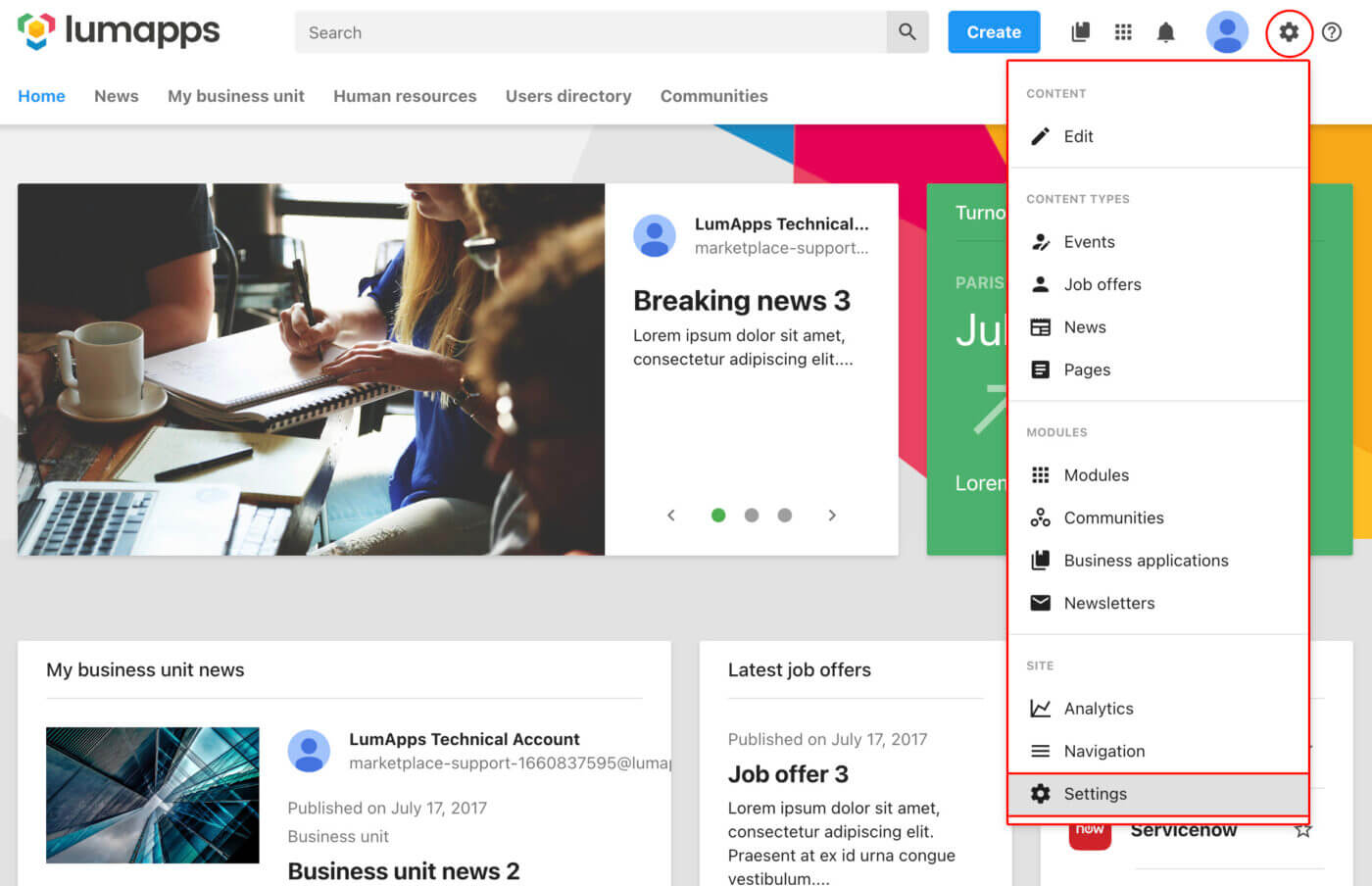
Overview
LumApps describes itself as a sophisticated employee experience platform with strong personalisation, communities, multilingual support and Google Workspace integration (also supports Microsoft 365). It’s used by global enterprises with more complex structures.
G2 / review scores
-
G2 listing: Rated 4.3 out of 5 stars based on 92 verified reviews.
-
Pros page: Users say it excels in ease of use, integration and flexibility.
Pros
-
Strong for global enterprises: multilingual support, segmentation, personalisation, intranet + experience platform scope.
-
Good integration with Google Workspace (and also Microsoft 365) so for organisations already in those ecosystems, strong fit.
-
Flexibility in content creation, good widgets, ability to roll out microsites, build internal communities. One user: “we were able to stand up a very usable digital employee experience in an amazingly short timeframe.”
-
Good search, metadata, content management.
Cons
-
While good, some users say setup/customisation can be heavier than “lighter” tools: “setting up microsites can be cumbersome.”
-
Possibly less strong if you are purely in the Google ecosystem but also heavy Microsoft/other systems requiring very deep customisation—though they do support both.
-
As always with enterprise-grade tools: buyer beware of deployment cost/time/resource.
Best fit
Global or large enterprise organisations that have complex internal structures, multilingual/multi-region operations, large employee base, require strong intranet + employee experience functionality, want strong integration with Google or Microsoft ecosystems. Less ideal if you simple need a lightweight intranet, or your budget/time to deploy needs to be minimal.
2. Unily
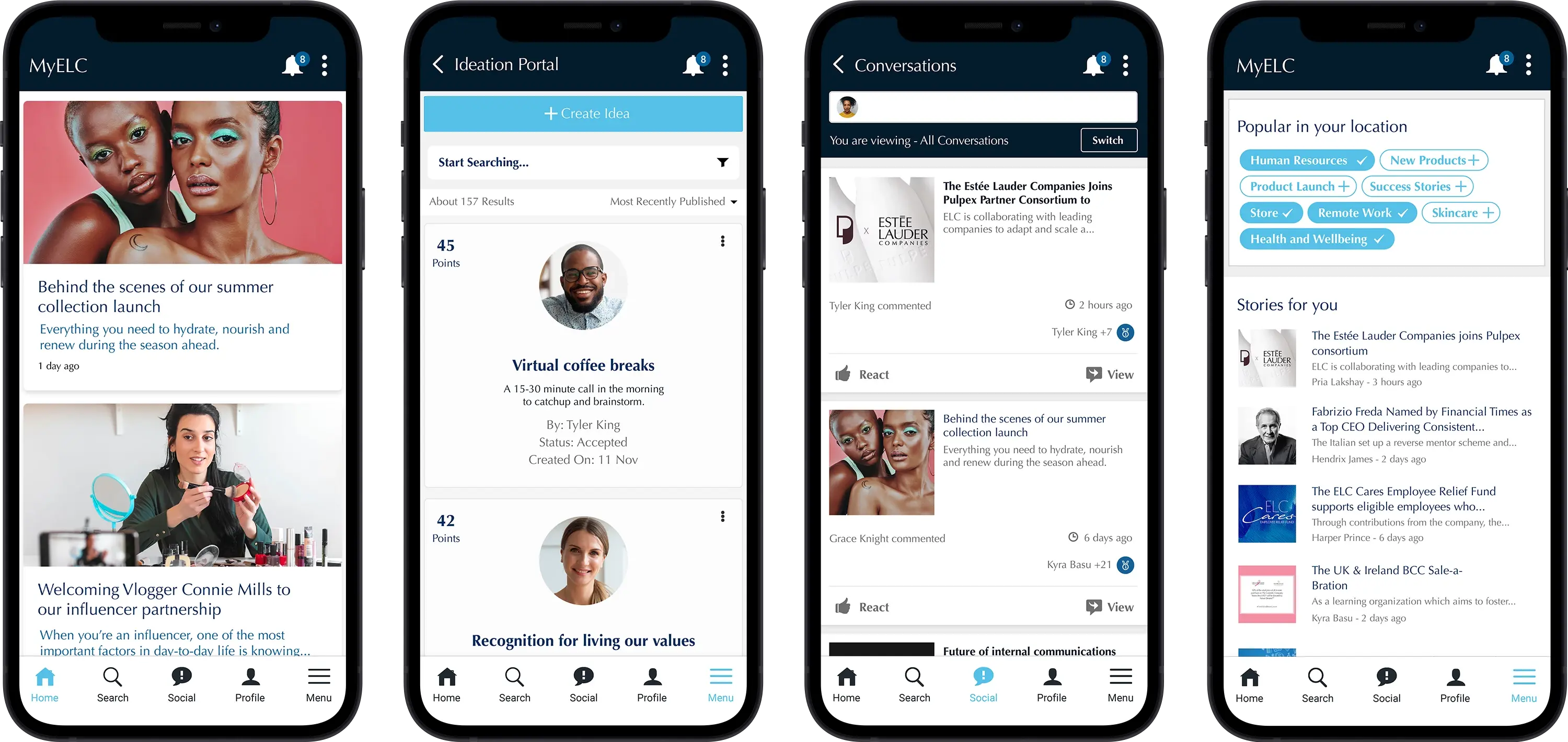
Overview
Unily is an enterprise-scale intranet platform built for global organisations with deep governance, sophisticated personalisation, analytics, multilingual capabilities and large-scale deployment. It is positioned as the heavy-duty platform when you have enterprise complexity.
G2 / review scores
-
On G2: Rated 4.5 out of 5 stars (31 verified reviews).
-
In comparison pages: Unily shines with high scores: e.g., in one compare vs SharePoint: Ease of Use ~9.2 vs SharePoint ~7.7; News Feed ~9.8; etc.
-
Compare vs Staffbase: Unily scored ~9.8 for Task Management whereas Staffbase ~5.4.
Pros
-
Very strong in governance, scaling, analytics, content control.
-
High customisation, strong widgets, enterprise capabilities: “You can control who has access to content, who can create it, and the permissions assigned to each role.”
-
Good for large global enterprises with complex intranet requirements: multilingual, multi-region, multi-division.
-
Rich in features for content management, workflows, large-scale deployments.
Cons
-
Because of its scope/complexity, deployment time/resource may be high: implementing may require significant investment.
-
Might feel over-engineered for smaller organisations or those wanting a fast-go-live.
-
The interface or experience may not feel as “lightweight” or “social-first” as more engagement-focused tools: if your priority is culture/engagement vs structure/knowledge, you might find it heavy.
Best fit
Large, complex, global enterprises with substantial intranet/knowledge/communication/governance needs. Organisations with multiple regions, languages, complex division/department structures, heavy personalisation, analytics, workflows. Less ideal if you are a mid-sized business wanting rapid deployment or focusing primarily on engagement/social rather than structured content/governance.
1. Oak Engage
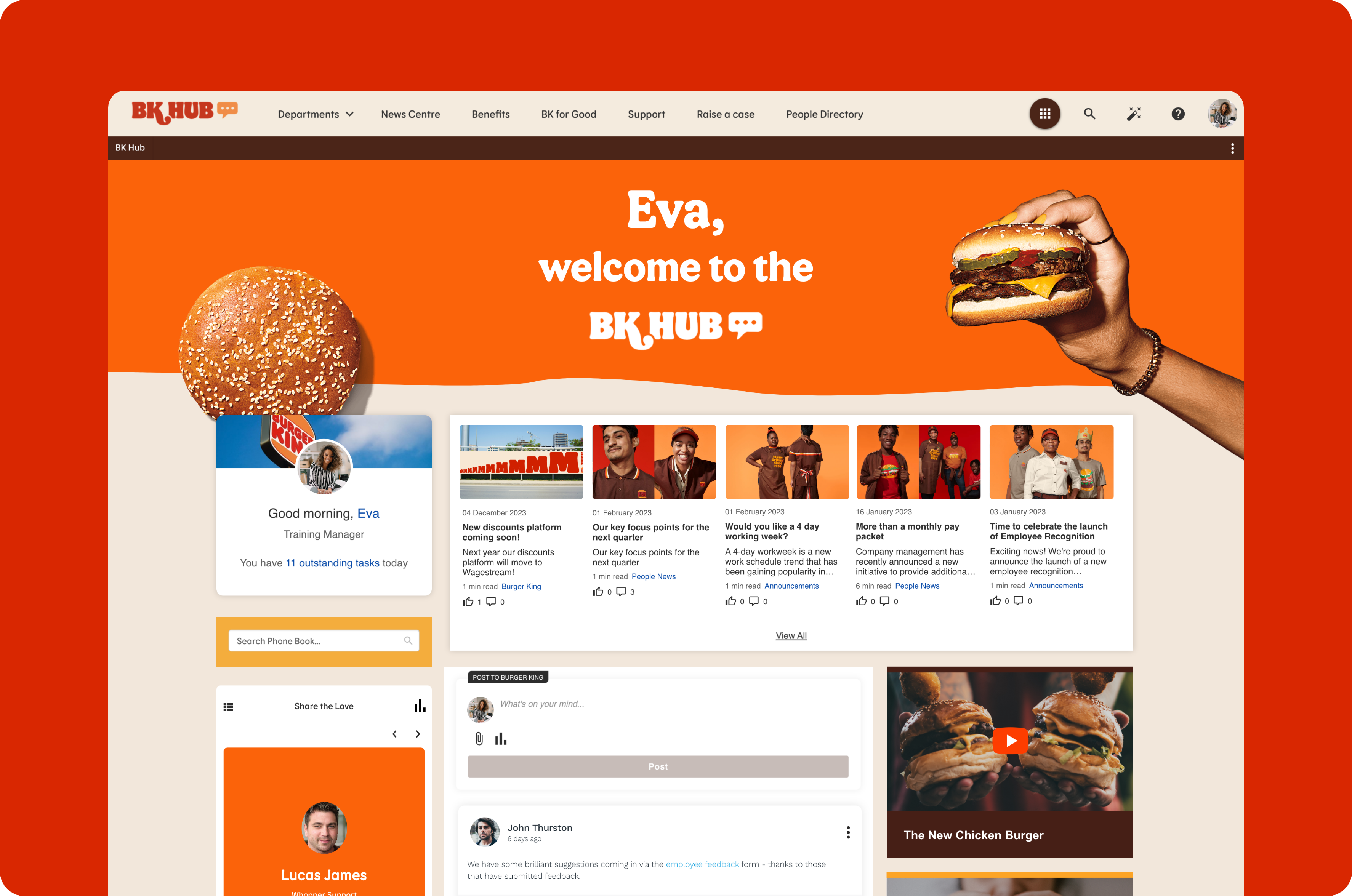
Oak Engage - Best intranet for enterprise organisations with 500+ employees
Oak Engage is the clear winner among modern intranet and employee engagement platforms—not just because it earns outstanding user reviews, but because it delivers market-leading value at a far more affordable cost.
With a 4.5/5 G2 rating, exceptional 97% Quality of Support, and 93% Meets Requirements scores in independent comparisons, Oak consistently matches—if not exceeds—the performance of heavyweight enterprise intranets that require significantly higher budgets and far longer deployment cycles.
Customers highlight Oak’s simplicity, rapid adoption, and standout support, but what truly sets Oak apart is how it combines these strengths with a dramatically lower total cost of ownership, faster implementation, and quicker time-to-value. Oak provides the impact and capability of an enterprise-grade platform without the enterprise-grade price tag, making it the smartest, highest-value choice for organisations seeking real results without undue complexity.
G2 / User Review Evidence
Oak Engage maintains consistently strong sentiment on G2 with real, verified user feedback emphasising ease, support, customisation and overall experience.
-
4.5/5 star average across verified G2 reviews
-
Independent comparisons show:
-
Quality of Support: 97%
-
Meets Requirements: 93%
-
Ease of Admin: ~93%
-
Ease of Use: ~90%
-
-
Users frequently describe Oak as “easy, simple and fun,” with standout praise for branding customisation and responsive support.
Strengths
Exceptionally user-friendly and intuitive
Customers consistently praise Oak for being easy to use, quick to learn, and simple to manage—driving high adoption across frontline and desk-based teams.
Outstanding support and customer success culture
With support metrics approaching 97%, Oak’s success team is noted as a major differentiator, offering rapid response, proactive guidance, and dedicated account partnership.
Strong branding and customisation
Organisations value the ability to create a branded internal environment, tailor layouts, and build visually engaging experiences without heavy technical overhead.
Balanced platform: engagement intranet
Oak offers the ideal mix of communication tools, engagement features and structured intranet capability, giving organisations the best of both worlds without unnecessary complexity.
Market-leading value and affordability
Oak provides advanced intranet and engagement features at a significantly lower total cost than many enterprise vendors. Faster deployment, fewer resources required, and simpler admin contribute to exceptional long-term value.
Faster time-to-value vs enterprise incumbents
Where large intranet platforms often require months of configuration, Oak can be rolled out far faster, helping organisations see results quickly.
Considerations
While Oak is a leader in value, usability and support there some considerations to bear in mind:
-
Limited advanced layout flexibility – A few users would like more design/customisation options for pages beyond current templates.
-
Not positioned as a “heavyweight” enterprise behemoth – Organisations needing extremely deep custom workflows, fully bespoke governance structures or highly complex global configurations may look to the largest enterprise intranet suites.
-
Smaller volume of public reviews – Oak has fewer total G2 reviews than the biggest vendors, though the feedback quality and scores are consistently high.
Best Fit
Oak Engage is ideal for mid-sized to large organisations that want:
-
A modern, intuitive intranet and engagement experience
-
Fast rollout and high adoption
-
Strong branding/customisation
-
Exceptional customer support
-
High impact without the cost or complexity of enterprise intranets
Oak’s combination of market-leading support, high satisfaction scores, simple management, and significantly stronger value-for-money makes it a standout winner. For organisations that prioritise usability, adoption, support and affordability, Oak Engage delivers a uniquely compelling proposition that outperforms many larger, more expensive alternatives, proving that “enterprise-grade” doesn’t need to mean “enterprise-priced.”
Conclusion: choosing the best intranet for you
Selecting the right intranet is ultimately about finding a platform that reflects the way your organisation communicates, collaborates and grows. Every business has different priorities, whether that is creating a central source of truth, improving the employee experience, supporting frontline teams or building a stronger culture.
The platforms in this list each excel in different areas, which is why matching your challenges to the right solution is more important than following trends.
For enterprise organisations with more than 200 employees, the need for clarity, personalisation and consistent reach becomes even more significant. This is where modern intranet platforms such as Oak Engage stand out, offering an experience that brings communication, knowledge and engagement into one integrated environment.
Whatever platform you choose, the aim remains the same: creating a more connected, informed and supported workforce that can do its best work every day.
Frequently Asked Questions
1. What should the best intranet include?
A modern intranet should offer more than just pages and documents. At a minimum, it should include:
-
Targeted news and updates
-
Clear navigation and search
-
A centralised policy or document hub
-
Mobile access for frontline and remote workers
-
Personalised content based on role, team or location
-
Integrations with Microsoft 365, Google Workspace and HR systems
-
Engagement features such as comments, surveys or recognition
-
Analytics that show who is engaging and who is not
If a platform can’t deliver these as standard, it won’t meet the expectations of a distributed workforce.
2. Do we need an intranet if we already use Teams, Slack or email?
Yes, because these tools solve different problems.
-
Teams/Slack = communication, chat and collaboration
-
Email = external communication and long-form updates
-
Intranet = structure, clarity, consistency and a single source of truth
Most organisations use all of them together. The intranet is the backbone that brings everything into one place.
3. How should we think about intranet cost?
Intranet software costs vary widely based on organisation size and feature set.
-
For smaller organisations, expect a lower-tier subscription or licence cost with simpler features.
-
For mid-sized organisations, expect a broader feature set (personalisation, mobile, integrations) and accordingly higher costs.
-
For large enterprises, expect a premium cost reflecting global reach, advanced governance, analytics, multilingual support and large user counts.
Also remember: lower upfront software cost can be offset by internal resource, customisation and maintenance costs—so total cost of ownership matters.
4. How long does it take to launch an intranet?
Launch timelines typically fall into these ranges:
-
Simple SaaS intranets: a few weeks
-
More fully-featured mid-sized intranets: a few months
-
Enterprise-grade or heavily customised intranets: six months or more
Your timeline will depend heavily on content preparation, integrations, internal readiness and change management
5. What makes an intranet platform “best” or top-tier?
Top intranet software is more than just a file-share site. It will typically offer:
-
a modern, intuitive user experience (mobile & desktop)
-
strong integration with your existing systems (HRIS, SSO, Microsoft 365/Google Workspace)
-
deep capabilities for communication, knowledge capture, search and personalised content
-
analytics to measure adoption and success, plus governance/customisation to scale
-
robust mobile/remote access if your workforce is hybrid or includes frontline workers
6. What is the difference between an intranet and an employee app?
-
Intranet: a full digital workplace with navigation, knowledge, governance, personalisation and structured content.
-
Employee app: lightweight mobile communication with updates, notifications and simpler features.
Many organisations use both. A strong intranet often includes an employee app as part of its mobile experience.
Change the way you work. Empower your people
We offer a free and personalised demo service, showcasing our intuitive and easy to use platform.
